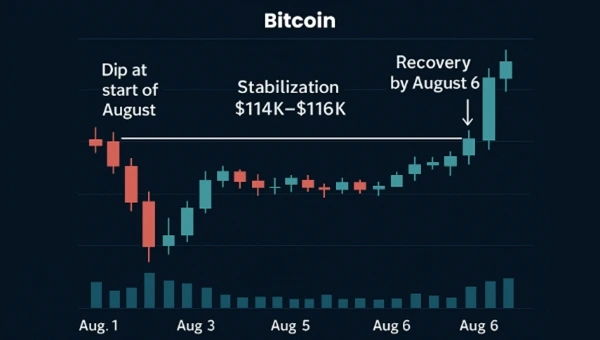

Tariffs, Crypto & Selloff
Bitcoin entered August with a 3% drop to $113,231.41, as markets reacted to Donald Trump’s newly announced tariffs of 10% to 41% on imports. The policy, effective August 7, sparked a wave of liquidations totaling $900 million, with $228 million wiped from Bitcoin trades alone, per CoinGlass data.
Simultaneously, weaker U.S. labor figures weighed on sentiment. Nonfarm payrolls came in under expectations, amplifying concerns of a slowdown. CryptoRank data shows August has long been a difficult month for digital assets, with an average 8.3% drop across 13 years, often linked to global economic nerves and thinner market activity.
The tariff shock extended beyond Bitcoin. Ethereum slid 6%, Solana fell 5%, and XRP dropped 6.27% to $2.97, based on internal estimates. Crypto-adjacent stocks suffered sharper losses: Coinbase plunged 16% after its Q2 earnings, Circle declined 8.4%, and Galaxy Digital dropped 5.4%.
The selloff reflected a broad retreat from risk. Yet on-chain metrics told a more nuanced story. Exchange balances declined, suggesting some investors were holding rather than selling, a contrast to August 2014, when Bitcoin sank 12% amid widespread panic.

Trajectory of BTC
U.S. regulatory developments have played a key role in Bitcoin’s 2025 trajectory. Trump’s executive order in March establishing a strategic Bitcoin reserve helped lift prices 15% YTD, beating the S&P 500’s 7% rise.
Congress added momentum with the GENIUS and CLARITY Acts, which improved regulatory visibility. Spot Bitcoin ETFs benefited, attracting $14.4 billion in inflows by early July. BlackRock’s iShares fund alone drew $370.2 million on a single day in January.
Still, sentiment had turned by July 31, with $114.83 million flowing out of Bitcoin ETFs and $465 million from Ethereum products, reflecting rising caution over Trump’s tariff announcements. Meanwhile, institutional players stayed active. MicroStrategy revealed a $4.2 billion Bitcoin plan, and Coinbase added 2,509 BTC in Q2.
By August 6, 2025, Bitcoin had stabilized at $116,240, holding above the 38.2% Fibonacci retracement level. Market volatility eased, with a 7-day price range narrowing to 3.2%, and the Fear & Greed Index reached 54, indicating neutral sentiment. Kraken reported a 9,600 BTC outflow on July 22, suggesting whale accumulation during the dip. This resilience differed from the 75% drop between 2017 and 2018, with Bitcoin’s market dominance at 61%. The crypto market cap stood at $2.36 trillion, with trading volume up 10.45% to $66.32 billion.
Looking Forward
Bitcoin’s next moves hinge on key price levels—support near $114,500 and resistance around $118,859. Markets remain focused on U.S. tariffs and economic data, including revised nonfarm payrolls. ETF inflows of $14.4 billion and regulatory progress continue to support institutional demand.
With a market cap of $2.36 trillion and rising trading volume, crypto activity remains elevated. Past cycles, such as the 2021 rebound after China’s ban, still demonstrate resilience. Investors are now watching the Federal Reserve and global trade signals as Bitcoin enters Q4.
He has worked with several companies in the past including Economy Watch, and Milkroad. Finds writing for BitEdge highly satisfying as he gets an opportunity to share his knowledge with a broad community of gamblers.
Nationality
Kenyan
Lives In
Cape Town
University
Kenyatta University and USIU
Degree
Economics, Finance and Journalism


Facts Checked by Vlad Hategan

 Fact checked by
Fact checked by 
 eabungana@gmail.com
eabungana@gmail.com 